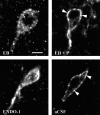Progesterone blockade of estrogen activation of mu-opioid receptors regulates reproductive behavior
- PMID: 11466444
- PMCID: PMC6762652
- DOI: 10.1523/JNEUROSCI.21-15-05723.2001
Progesterone blockade of estrogen activation of mu-opioid receptors regulates reproductive behavior
Abstract
The mu-opioid receptor (MOR), a G-protein-coupled receptor, is internalized after endogenous agonist binding. Although receptor activation and internalization are separate events, internalization is a good assay for activation because endogenous opioid peptides all induce internalization. Estrogen treatment of ovariectomized rats induces MOR internalization, providing a neurochemical signature of estrogen activation of the medial preoptic nucleus. MOR activation appears to be the mechanism via which estrogen acts in the medial preoptic area to prevent the display of female reproductive behavior during the first 20-24 hr after estrogen treatment. Naltrexone, an alkaloid universal opioid receptor antagonist, prevented MOR internalization, suggesting that estrogen induces the release of endogenous opioid peptides that in turn activate the MOR. Enkephalins and beta-endorphin are nonselective endogenous MOR ligands. The most selective endogenous MOR ligands are the endomorphins. Infusions of selective MOR agonists, H-Tyr-d-Ala-Gly-N-Met-Phe-glycinol-enkephalin (DAMGO) or endomorphin-1, into the medial preoptic nucleus attenuated lordosis, and their effects were blocked with the MOR antagonist H-d-Phe-Cys-Tyr-d-Trp-Orn-Thr-Pen-Thr-NH(2) (CTOP). Infusion of endomorphin-1 internalized MOR. To determine whether progestin also acts via the MOR system to facilitate reproductive behavior, ovariectomized rats were primed with 17beta-estradiol and progesterone. Progestin facilitation of lordosis was correlated with a reduction of estrogen-induced MOR internalization. Progestin reversed estrogen-induced MOR internalization, suggesting that progesterone blocked estrogen-induced endogenous opioid release, relieving estrogen inhibition and facilitating lordosis. These results indicate a central role of MOR in the mediation of sex steroid activation of the CNS to regulate female reproductive behavior.
Figures








Similar articles
-
Estrogen-induced mu-opioid receptor internalization in the medial preoptic nucleus is mediated via neuropeptide Y-Y1 receptor activation in the arcuate nucleus of female rats.J Neurosci. 2004 Jan 28;24(4):947-55. doi: 10.1523/JNEUROSCI.1366-03.2004. J Neurosci. 2004. PMID: 14749439 Free PMC article.
-
Activation of mu-opioid receptors inhibits lordosis behavior in estrogen and progesterone-primed female rats.Horm Behav. 2002 Feb;41(1):88-100. doi: 10.1006/hbeh.2001.1741. Horm Behav. 2002. PMID: 11863387
-
Estrogen-induced alteration of mu-opioid receptor immunoreactivity in the medial preoptic nucleus and medial amygdala.J Neurosci. 1998 May 15;18(10):3967-76. doi: 10.1523/JNEUROSCI.18-10-03967.1998. J Neurosci. 1998. PMID: 9570823 Free PMC article.
-
Engineering endomorphin drugs: state of the art.Expert Opin Ther Pat. 2012 Jan;22(1):1-14. doi: 10.1517/13543776.2012.646261. Epub 2012 Jan 4. Expert Opin Ther Pat. 2012. PMID: 22214283 Free PMC article. Review.
-
The µ opioid receptor and ligands acting at the µ opioid receptor, as therapeutics and potential therapeutics.Curr Pharm Des. 2013;19(42):7415-34. doi: 10.2174/13816128113199990362. Curr Pharm Des. 2013. PMID: 23448479 Review.
Cited by
-
β-arrestin regulates estradiol membrane-initiated signaling in hypothalamic neurons.PLoS One. 2015 Mar 24;10(3):e0120530. doi: 10.1371/journal.pone.0120530. eCollection 2015. PLoS One. 2015. PMID: 25803606 Free PMC article.
-
mu-opioid receptor-mediated antinociceptive responses differ in men and women.J Neurosci. 2002 Jun 15;22(12):5100-7. doi: 10.1523/JNEUROSCI.22-12-05100.2002. J Neurosci. 2002. PMID: 12077205 Free PMC article. Clinical Trial.
-
Gender issues in the pharmacotherapy of opioid-addicted women: buprenorphine.J Addict Dis. 2010 Apr;29(2):217-30. doi: 10.1080/10550881003684814. J Addict Dis. 2010. PMID: 20407978 Free PMC article.
-
Release of orphanin FQ/nociceptin in the medial preoptic nucleus and ventromedial nucleus of the hypothalamus facilitates lordosis.Horm Behav. 2007 Mar;51(3):406-12. doi: 10.1016/j.yhbeh.2006.12.008. Epub 2006 Dec 22. Horm Behav. 2007. PMID: 17274997 Free PMC article.
-
Estradiol Membrane-Initiated Signaling in the Brain Mediates Reproduction.Trends Neurosci. 2017 Nov;40(11):654-666. doi: 10.1016/j.tins.2017.09.001. Epub 2017 Sep 29. Trends Neurosci. 2017. PMID: 28969926 Free PMC article. Review.
References
-
- Babcock AM, Block GJ, Micevych PE. Injections of cholecystokinin into the ventromedial hypothalamic nucleus inhibit lordosis behavior in the rat. Physiol Behav. 1988;43:195–199. - PubMed
-
- Beach F. Hormones and behavior. Hoeber; New York: 1948.
-
- Eckersell CB, Micevych PE. Opiate receptors modulate estrogen-induced cholecystokinin and tachykinin but not enkephalin mRNA levels in the limbic system and hypothalamus. Neuroscience. 1997;80:473–485. - PubMed
Publication types
MeSH terms
Substances
Grants and funding
LinkOut - more resources
Full Text Sources
Other Literature Sources
Research Materials
Miscellaneous
